January 6, 2022, by Kathryn Steenson
Happy Census Release Day!
On a Sunday afternoon at the tail end of a global pandemic, millions of people in the UK sat down to complete the decennial census forms, a head count of everyone in the country on a given day. I could be referring to 2021, but as today is Census Release Day, you’ve probably guessed that it’s actually a reference to 1921.
One of those people was Thomas Shipstone of Lenton Firs, just off Derby Road on what is now Nottingham’s University Park Campus. The campus did not exist in 1921, and instead it was an exclusive area of large houses, sprawling estates, and farmland. Many of those houses still stand, although today they are home to various university departments.
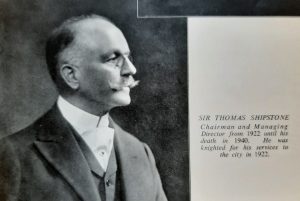
Photo of Sir Thomas Shipstone, taken from ‘The House of Shipstone 1852-1952’. Ref: EMC Pamphlet Not 4C.O52 BRE
The original Georgian villa of Lenton Firs was built in 1800 by Thomas Wright Watson, a Nottingham hosiery manufacturer, but he died soon after without really getting the chance to enjoy it. A later resident, Thomas Adams, oversaw a major modernisation project. He had the larger bay windows installed to take in the view of the surrounding fields and woodland, with the village of Lenton and beyond that Nottingham Castle visible in the distance. Adams also had local architect T C Hine design Lenton Firs Lodge, the gatehouse built on Derby Road in 1861 that was home to the estate’s head gardener and his family.
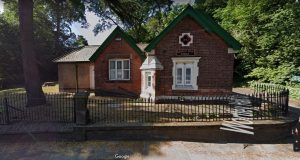
Screenshot of Lenton Firs Lodge from Derby Road, taken from Google Streetview in 2021. In 1921, coachman Eli Sharp lived here.
Sixty years later, the 19-acre estate was owned by Thomas Shipstone, who had made his fortune through the family brewing company Shipstone & Sons of Basford (he was one of the sons). He had lived there since 1903, and spent the years buying up the neighbouring land and properties. The Lenton Firs estate had two large kitchen gardens, glasshouses, an aviary, various stables and outbuildings, and lawns and woodlands ornamented with classical statues and balustrades. Wide stone paths snaked through the grounds, large enough for his wife Eliza’s bath chair to navigate. It’s likely he had the Edwardian summer house built in what is now the Rock Garden, but was for many years after his death a derelict building hidden in a sycamore wood.
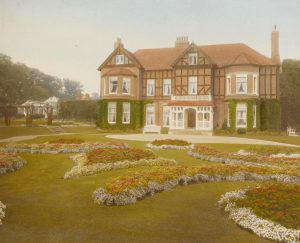
Hand coloured photograph of Lenton Firs and garden with wide, wheelchair-friendly pathways, c. 1930. Ref: MS 940/16

Hand-coloured photograph of the coachman at Lenton Firs, cleaning the coach in a yard. Ref: MS 940/12
The 1921 census catches him during a period of major life changes. He was widowed in 1919 when Eliza died after years of suffering from a degenerative spinal condition and the only other people living in Lenton Firs were five domestic servants. The following year he would become chairman of the brewing company after his brother James’s death, but also receive a knighthood and become Sir Thomas. In 1921 his coachman Eli Sharp still lived on the estate, but he would find himself out of a job the following year. Horse-drawn coaches gave way to new-fangled motor-cars, and he was replaced with a chauffeur, Edwin Matthews.
Partial transcription of the 1921 census entry – note his surname and address is mis-transcribed as ‘Shipston’ and ‘Lenton Fire’.
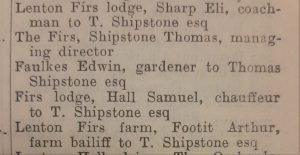
Entry for the Lenton Firs estate in Kelly’s Directory from 1922. Faulkes would remain gardener until 1940, but Footit would leave Shipstone’s employ shortly after Sharp. All three had been working for Shipstone since before he moved to Lenton Firs in 1903.
Thomas Shipstone lived at Lenton Firs until his death in 1940. The contents of the house was sold off the following year and the building became a convelescent home for members of the armed forces. In 1946, with the war over, the University of Nottingham acquired it as a Halls of Residence, initially for women, and from 1950 a men’s Halls of Residence with the new name of Wortley Hall. Shipstone’s library remained a library, but the billiard room with its modern stained glass window became part of the dining room. The kitchen gardens that had once fed the family were partially covered by an extension to provide study-bedrooms for students.

Shipstone’s property was sold off over a period of five days in 1941 by auctioneers. This sales catalogue has been annotated with the prices items fetched.
Ref: Catalogue of the sale of the costly furnishing contents of the residence… EMC Pamphlet Not 4P.D64 LEN
In 1987 it became, and still is today, part of the School of Architecture and the Built Environment. Modern extensions and roads have been added, but the older buildings are still there, as is much of the greenery. It is possible, if you pick the right moment and look in the right direction, to imagine standing in front of a half-timbered mansion admiring the sweeping views of perfectly manicured lawns, waiting for a horse-drawn carriage to appear from the driveway lined with sycamore trees.
The material here, with the exception of the 1921 census, is held by Manuscripts & Special Collections and is available to view in the Reading Room. We hold microfilm copies of the census returns for Nottinghamshire up until 1901, which may be old-school but is at least free to view. For visiting information and to book an appointment, go to nottingham.ac.uk/mss. For more information about the historic houses on University Park, see https://www.lakesidearts.org.uk/SiteData/Root/File/Visit%20us/heritageguide.pdf
The 1921 census is available to view on a pay-per-view basis at FindMyPast.co.uk, or free on-site at The National Archives, National Library of Wales and Manchester Central Library.
No comments yet, fill out a comment to be the first

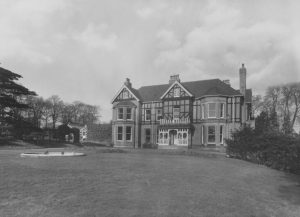
Leave a Reply